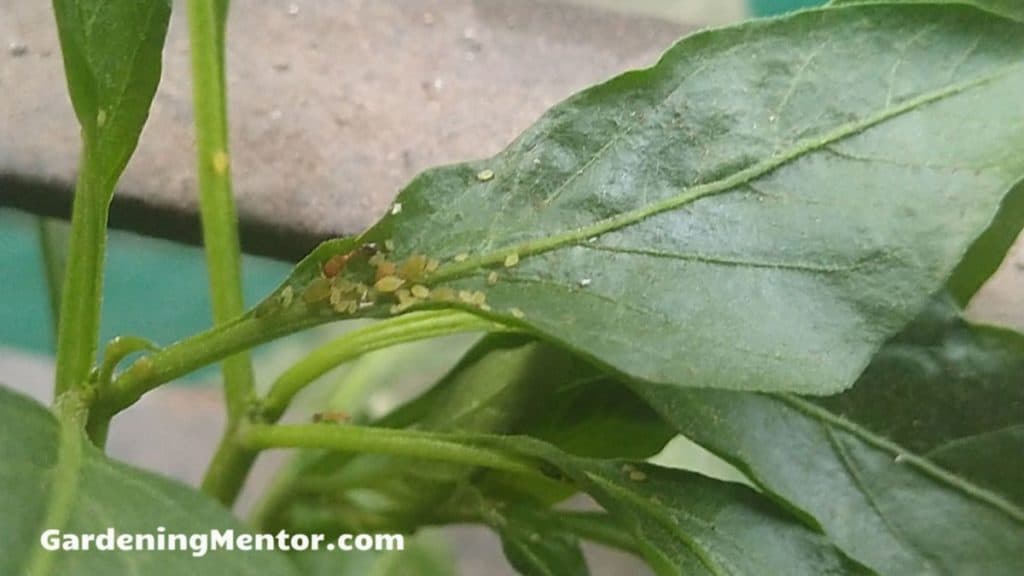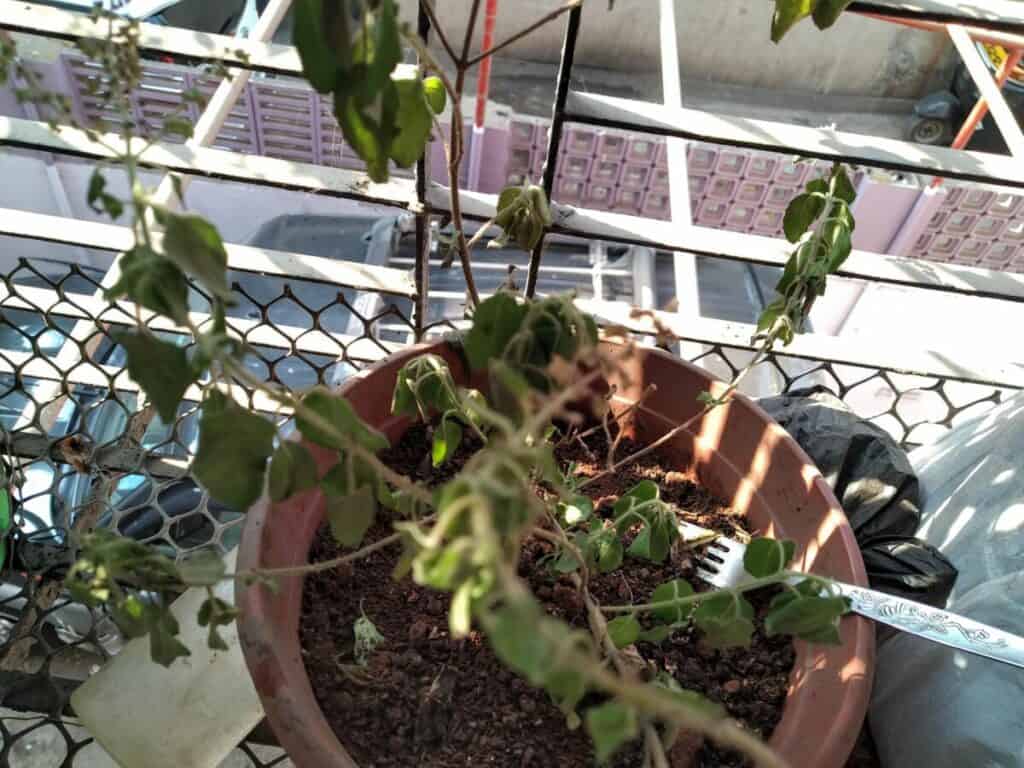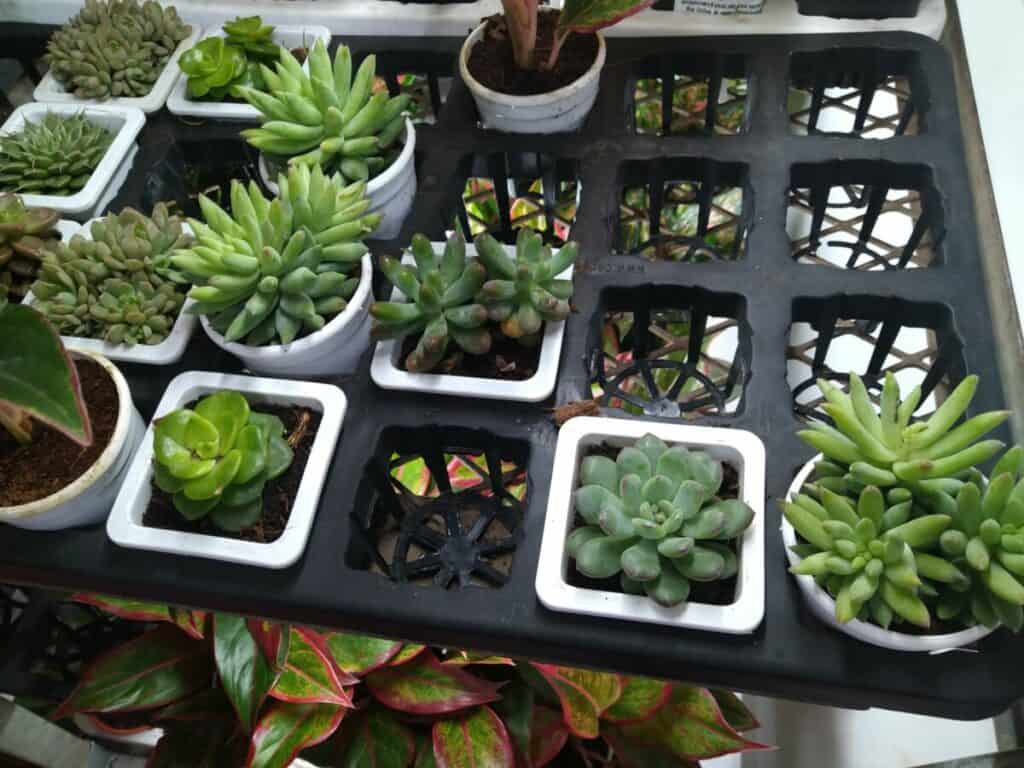When you grow potted plants, there are times when it will look like the plant has died. But you need to be sure as they may still be alive even when they appear that way.
You can tell if the potted plant is dead by using the scratch method. If the outer layer scrapes easily and shows damp, green tissue, the plant is alive. If it’s hard, brown, and difficult to scrape, it’s dead. You can check the roots if they are white and healthy or blackened.
There are plenty of reasons that will tell you whether your potted plant is dead or not. And you may be able to get them back to their healthy state as well.
1. Check the leaves of the plant
The first thing you should do is check the leaves of your potted plant. They are the first to show signs that something is wrong with the plant.
It might have happened that all the leaves of the potted plant have fallen off. But that does not necessarily mean that the potted plant has died.
There are some plants like perennials that will go dormant during the cold season of winter. They will shed their leaves to protect themselves till the next spring arrives.
If the leaves have turned yellow and are falling off, it could be due to overwatering. This is a serious problem where the roots drown in excess water and the potted plant will eventually die.
If the leaves are turning brown in color and falling off it could be because the plant is getting less water. If this happens for a long time, the plant will die.
The leaves of the plant may also start turning brown at the edges if there is too much nitrogen in the potting soil. This may happen if you have overfertilized the potting soil.
If your potted plant does not get the required nutrients, it will reflect from the leaves. They will start turning yellow and falling off. But you just need to add nutrients to the potting soil and they will become healthy.
If there is a lot of cold wind flowing through your garden, the leaves of the potted plant will start getting scorched. But that does not mean the potted plant is dying and the leaves will return to a healthy state as soon as you protect the plant.
The same can be said about your potted plant receiving a lot of heat from the sun. This will cause the leaves to shrivel up trying to protect themselves. But you can move the potted plant to a shady location and it will return to normal pretty soon.
2. Check the stem of the plant
The next part of the potted plant to check is the stem. You can use the scrap method to find out whether your potted plant is dead or not.
Use a knife and scrape the stem to check the color underneath. If the stem is green in color under the bark, it means the potted plant is still alive even if all of the leaves have fallen off.
If you find that the stem is brown under the bark, go a couple of inches below the spot and scrape the bark again.
If you keep doing this and find that no portion of the stem remains green, that’s a sign that the potted plant has died.
3. Check the branches of the plant
The health of the branches will also let you know if your potted plant is dead or not. You can twist a branch and check how pliable it is.
If it snaps off the plant, that’s a sign that the plant is dead. But if it bends without breaking, the plant is still alive. If you cut the branch, you will see green color and moisture inside it if the plant is alive.
You can try a couple of branches at different parts of the plant to know whether some portion of the plant has dried out.
4. Check the roots of the plant
The health of the roots of the potted plant is a good sign of whether the plant is dead or alive. You can dig the potting soil around the roots to check them. Or you can take the plant completely out of the potting soil to inspect the roots.
Healthy roots are white and dry in appearance. If you find the roots are black or brown and soggy it means they are suffering from a disease.
Root rot is a common problem when you overwater the potted plant causing the roots to drown. The humid condition causes fungal diseases to infect the roots causing them to rot. The roots will also emit a foul smell when such conditions take place.
Another problem that may happen is the potted plant has outgrown the pot. This causes the plant to be root-bound. This means the roots don’t have space so they circle the pot into a mess.
The roots can’t get the required moisture and nutrients in such a condition where they have outgrown the pot and cause the potted plant to die.
5. Check the plant for pests and diseases

Check the plant for a heavy infestation of pests and diseases. That’s a sign that your potted plant will soon die if you don’t take care of the problem.
The pests such as aphids, spider mites, and mealybugs will attack the foliage and suck the sap out of the leaves. This will cause a lack of nutrients and eventually death of the potted plant.
The same is the problem with fungal, bacterial, and viral diseases attacking the plant. This depends on the type of disease but some of them will show up on the foliage and branches of the plant as white, black, or brown spots and rings.
How to bring a dead potted plant back to life
Plants are resilient and you may be able to bring your potted plant back to good health. This depends on the extent of damage done to the plant.
If all the roots of the plant have been damaged, you won’t be able to restore the plant. Or if the plant is infected by bacterial or viral diseases, the plant will eventually die and you can’t do much about that.
But if the roots are healthy and the plant is still alive but in bad shape, there’s a good chance it will get back to health if you take care of it. I’ve written some things you should start working on to get started with this.
Water the plant well
If your potted plant has gone dormant because of improper watering that is where you can start. If the plant has suffered overwatering, you need to stop watering first.
Let the potting soil dry out before you consider watering the plant again. If the roots are suffering from root rot, you’ll need to repot the plant in fresh potting soil.
You can take the plant out of the pot and throw away the potting soil. Sterilize the pot by soaking it in a solution of 1 part bleach and 9 parts water for an hour. Then rinse it with water to clean it up and let it dry.
Once the pot is dry, you can add a fresh batch of potting soil and then place the plant roots into the soil. Cover them up well and water the potting soil well till it drains out from the bottom through the drainage holes.
If the potted plant has suffered underwatering, you will need to start watering it well again. If the potting soil has become hard, you’ll need to soak it in a tub till it can start absorbing moisture again.
Once the plant has recovered, you’ll need to maintain a good watering schedule. First, you should understand the type of plant you’re growing and the moisture that it needs.

Some plants like succulents prefer the soil to be dry and watering has to be less. But others may need frequent watering for the potting soil to remain moist. I recommend checking on your potted plant every morning.

Stick your finger 1-2 inches in the potting soil and check for the moisture in the potting soil. If the tip of your finger does not feel moist, it’s time to give the potting soil good watering.
Water the potting soil till the water starts coming out from the drainage holes at the bottom indicating good watering.
Give the plant enough sunlight
Check if your potted plant needs plenty of sunlight or shade. This again depends on the type of plant you’re growing so do some research about it.
If the plant needs full sunlight you need to keep it in a location that gets at least 6-8 hours of sunlight every day. If the plant needs partial shade, you need to keep it in an appropriate location that gets the required shade.
If you’re growing the potted plant indoors, you’ll need to place it near a windowsill that gets the required sunlight. Or you’ll need artificial lighting using grow lights or LED lights that can give sufficient light to the plant as it needs.
Get rid of pests on the plant
If your potted plant is dying because of pests, you’ll need to get rid of them. You will need to understand what kind of pest it is so you can get rid of them.
Some pests like aphids and spider mites will attack the foliage and are easy to get rid of. You can spray water to dislodge them to the ground and they won’t be able to get back.
If you can see the pests on the plant, you can pick them by hand and throw them in a bucket of soapy water. This works well with larger bugs as well as slugs and snails.
If the pests are very small, you may be able to get rid of them using neem oil, horticultural oil, or diatomaceous earth depending on the type.

If some parts of the plant have been damaged beyond recovery, you’ll need to cut off those parts.
Get rid of diseases on the plant
If your potted plant is infected with a disease, you might be able to recover it if it’s a fungal disease. You can use a fungicide and get rid of the problem.
If it’s a fungal issue such as root rot, you can trim the diseased roots and then repot to get the plant growing back again.
If it’s a fungal issue on the leaves, you can trim the infected leaves and use a fungicide till the problem goes away.
If the disease is a bacterial or viral one, you may not be able to get rid of it. You can just continue growing the plant till it eventually will die.
Give the plant required heat
The potted plant you are growing may be a cool-season or warm-season plant and you need to be aware of this.
If the plant is dying because of lack of heat or too much heat, you need to understand this to take action.
If the plant is a cool-season one, you need to keep it away from warm weather otherwise it will not survive. You may need to bring it indoors out of the warm sunlight so it can recover.
If the plant is a warm-season one, you need to grow it outside where it can get the required heat to grow well.
Provide sufficient nutrients to the plant
If the potted plant does not get sufficient nutrients it will begin to go dormant. I recommend adding compost to your potting soil when preparing it.
If you don’t have compost, you can mix in a slow-release organic fertilizer with the potting soil. This way there is a good supply of nutrients available to the plant.
You can add a small quantity of compost or fertilizer every month when the plant is growing. This will keep giving it a boost of nutrients over time.
If the potted plant is dying because you have overfertilized it, you need to flush the fertilizer out of the potting soil.
You should water the potting soil till the water drains out from the drainage holes at the bottom. Keep doing this 3-4 times so you can get as much fertilizer out of the potting soil as possible. Then avoid adding fertilizer for a few weeks till the plant can recover.

Protect the plant from transplant shock
If you had started your seeds indoors and then transplanted the plant to a pot in the garden outside, it can cause transplant shock.
The plant gets stressed because you moved it from a comfortable indoor environment to outside where there is more sunlight, heat, wind, and rain.
It’s best if you can harden the plant before moving it outdoors. You keep it outside every day for a few hours but away from the harsh elements. And in a week, it will be ready to move outside.
If the plant is suffering from transplant shock, it may be stressed and feel like it’s going to die. You mustn’t stress it further.
Don’t try to add fertilizer to the potting soil as that will cause the plant to get stressed trying to utilize the nutrients.
I would suggest moving the plant back to a comfortable indoor environment if you can. Then once the plant has recovered after a few days, you can consider the hardening process before moving it outside.
Repot the plant in the right sized container
If your potted plant has outgrown its pot, it won’t get the required nutrients and moisture from the potting soil. The plant will have become root-bound with the roots circling inside the pot.
You will need to transplant the plant to a pot that is 1-2 sizes bigger. Once you remove the plant from its current pot, you can try to separate the roots that have grown into a mass.
You can even cut off some of the roots or the outer layer of the circled mess that the roots may be in. Then you can transplant to potting soil in a larger pot.
I would suggest trimming some of the leaves and branches so that the roots don’t have as much work to do. Less foliage means the roots have to supply fewer nutrients and moisture to the plant.
The roots can focus on recovering from the trimming and becoming stronger over time.
What do you do with dead potted plants?
There will be times when you won’t be able to save your potted plant from dying. This will happen either because of some problem or because the plant has lived its life.
But you can still recycle the plants for further plants that you grow in your garden.
Add the dead plant to your compost pile
The best thing to do is add the dead plant to your compost pile. The leaves and branches will add nitrogen and carbon material to the compost.
Make sure to chop up the plant into small pieces before adding it to the compost pile. You also don’t want to add the plant to the pile if it was infested with pests or diseases.
If you don’t have a compost pile, you can give it to your family, friends, or neighbors that are making their own compost. Or you can donate it to a community compost pile if one is available.
Use the dead plant as mulch
If you don’t have a compost pile, the next option is to use the plant material as mulch in your potted plants. You can chop up the dried leaves and branches to use as mulch.
Make sure the plant did not suffer from pests and diseases before you try to use it as mulch.
You add the chopped-up pieces as a 1-2 inch layer on top of the potting soil. This layer of mulch will regulate the soil temperature.
It will also help the potting soil retain moisture for a longer period of time. So you won’t need to water the potted plants as often.
The mulch will also protect the potted plants from weed seeds as they won’t germinate under the layer of mulch.
As the mulch decomposes over time, it will add organic matter to the potting soil that enriches it and encourages beneficial microorganisms.

Fact Checked, Written, and Published by Kevin Rodrigues
Kevin is the founder of Gardening Mentor, a website that aims to teach people to grow their own food in a limited space. As a self-taught gardener, Kevin has spent several years growing plants and creating gardening content on the website. He is certified in Home Horticulture and Organic Gardening from Oregon State University. He has a Post Graduate Diploma in Horticulture and Landscape Gardening from Mumbai University.
Read more
